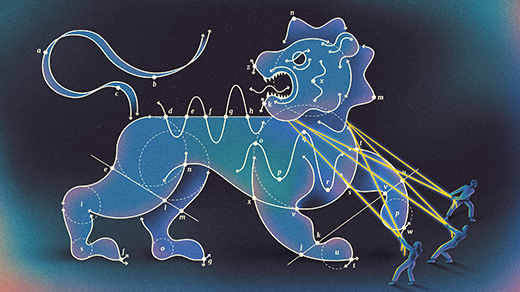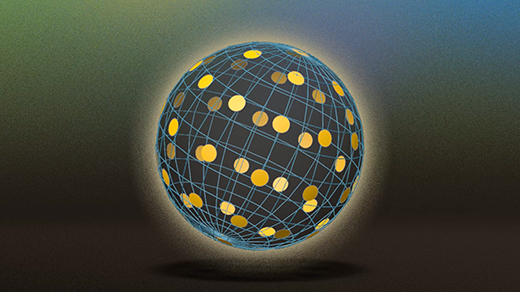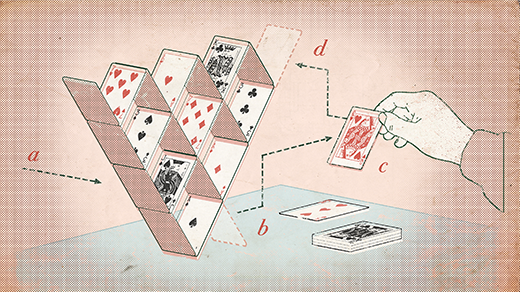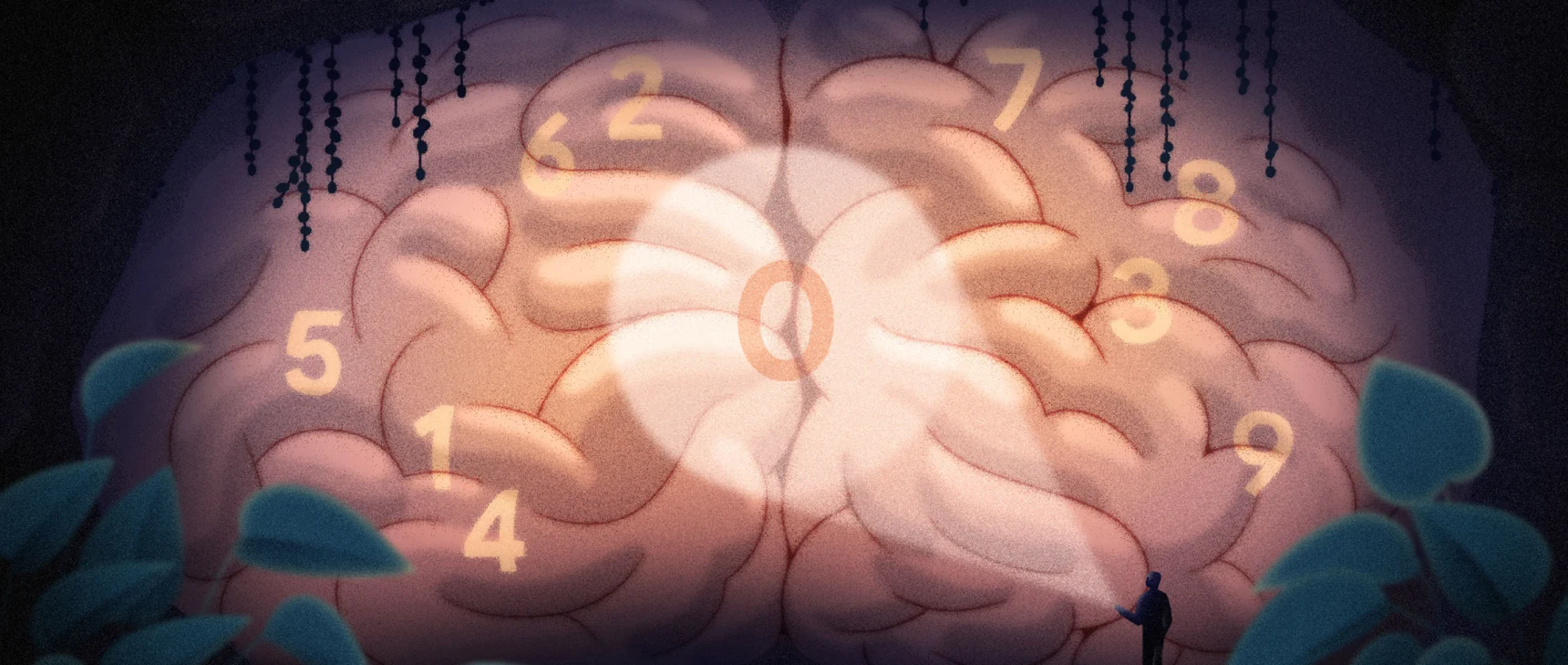Math Is Still Catching Up to the Mysterious Genius of Srinivasa Ramanujan
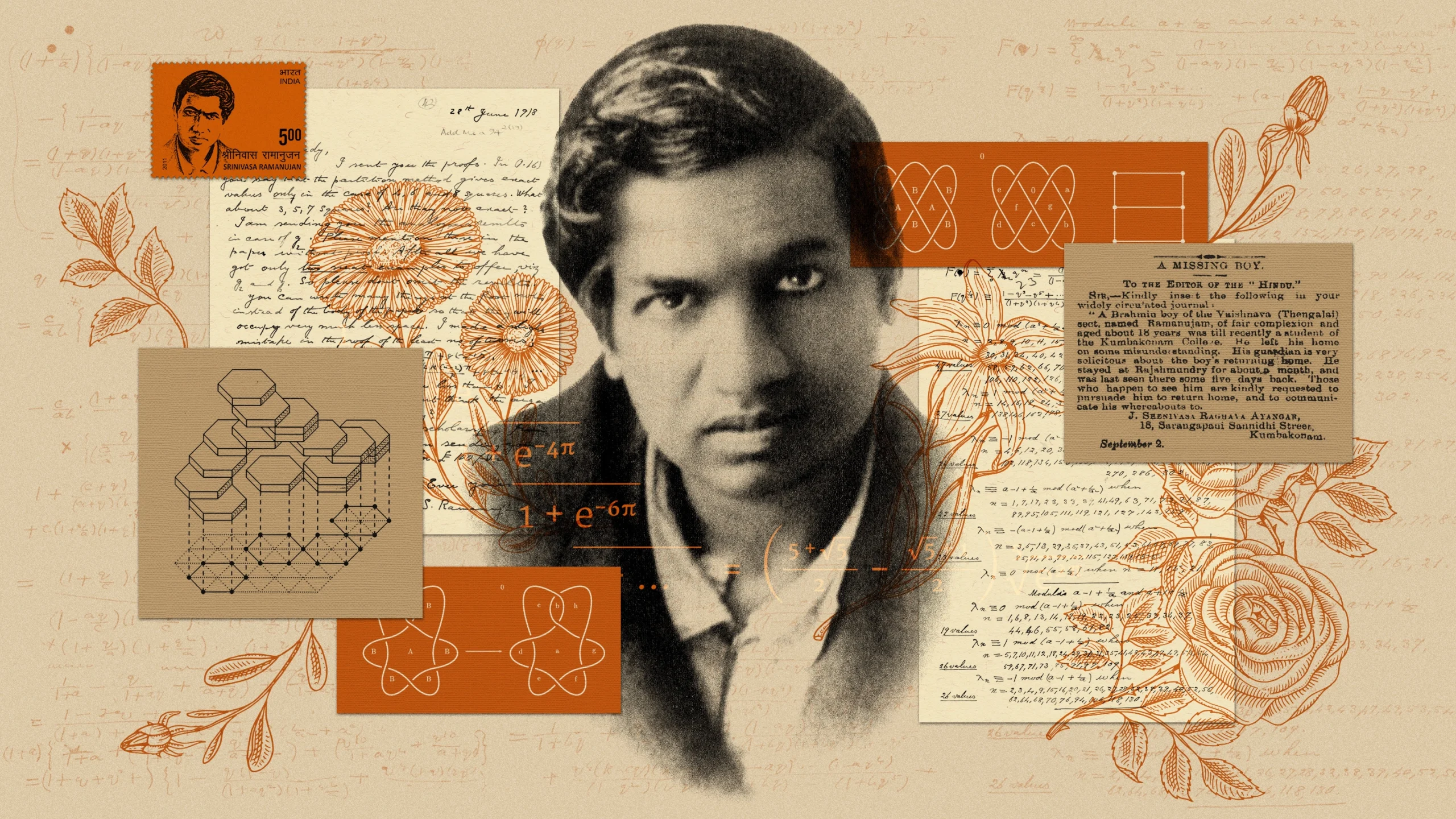
Kristina Armitage/Quanta Magazine
Introduction
One afternoon in January 2011, Hussein Mourtada leapt onto his desk and started dancing. He wasn’t alone: Some of the graduate students who shared his Paris office were there, too. But he didn’t care. The mathematician realized that he could finally confirm a sneaking suspicion he’d first had while writing his doctoral dissertation, which he’d finished a few months earlier. He’d been studying special points, called singularities, where curves cross themselves or come to sharp turns. Now he had unexpectedly found what he’d been looking for, a way to prove that these singularities had a surprisingly deep underlying structure. Hidden within that structure were mysterious mathematical statements first written down a century earlier by a young Indian mathematician named Srinivasa Ramanujan. They had come to him in a dream.
Ramanujan brings life to the myth of the self-taught genius. He grew up poor and uneducated and did much of his research while isolated in southern India, barely able to afford food. In 1912, when he was 24, he began to send a series of letters to prominent mathematicians. These were mostly ignored, but one recipient, the English mathematician G.H. Hardy, corresponded with Ramanujan for a year and eventually persuaded him to come to England, smoothing the way with the colonial bureaucracies.
It became apparent to Hardy and his colleagues that Ramanujan could sense mathematical truths — could access entire worlds — that others simply could not. (Hardy, a mathematical giant in his own right, is said to have quipped that his greatest contribution to mathematics was the discovery of Ramanujan.) Before Ramanujan died in 1920 at the age of 32, he came up with thousands of elegant and surprising results, often without proof. He was fond of saying that his equations had been bestowed on him by the gods.
More than 100 years later, mathematicians are still trying to catch up to Ramanujan’s divine genius, as his visions appear again and again in disparate corners of the world of mathematics.
Ramanujan is perhaps most famous for coming up with partition identities, equations about the different ways you can break a whole number up into smaller parts (such as 7 = 5 + 1 + 1). In the 1980s, mathematicians began to find deep and surprising connections between these equations and other areas of mathematics: in statistical mechanics and the study of phase transitions, in knot theory and string theory, in number theory and representation theory and the study of symmetries.
Most recently, they’ve appeared in Mourtada’s work on curves and surfaces that are defined by algebraic equations, an area of study called algebraic geometry. Mourtada and his collaborators have spent more than a decade trying to better understand that link, and to exploit it to uncover rafts of brand-new identities that resemble those Ramanujan wrote down.
“It turned out that these kinds of results have basically occurred in almost every branch of mathematics. That’s an amazing thing,” said Ole Warnaar of the University of Queensland in Australia. “It’s not just a happy coincidence. I don’t want to sound religious, but the mathematical god is trying to tell us something.”
New Worlds
Ramanujan’s mathematical prowess was obvious to those who knew him. Without formal training, he excelled; by the time he was in high school he had devoured advanced, though often outdated, textbooks, and was doing independent research on different kinds of numerical properties and patterns.
In 1904, he was granted a full scholarship to the Government Arts College in Kumbakonam, the small city where he had grown up, in what is now the Indian state of Tamil Nadu. But he ignored all subjects besides math and lost his scholarship within a year. He later enrolled in another university, this time in Madras (now Chennai), the provincial capital some 250 kilometers north. Again he flunked out.
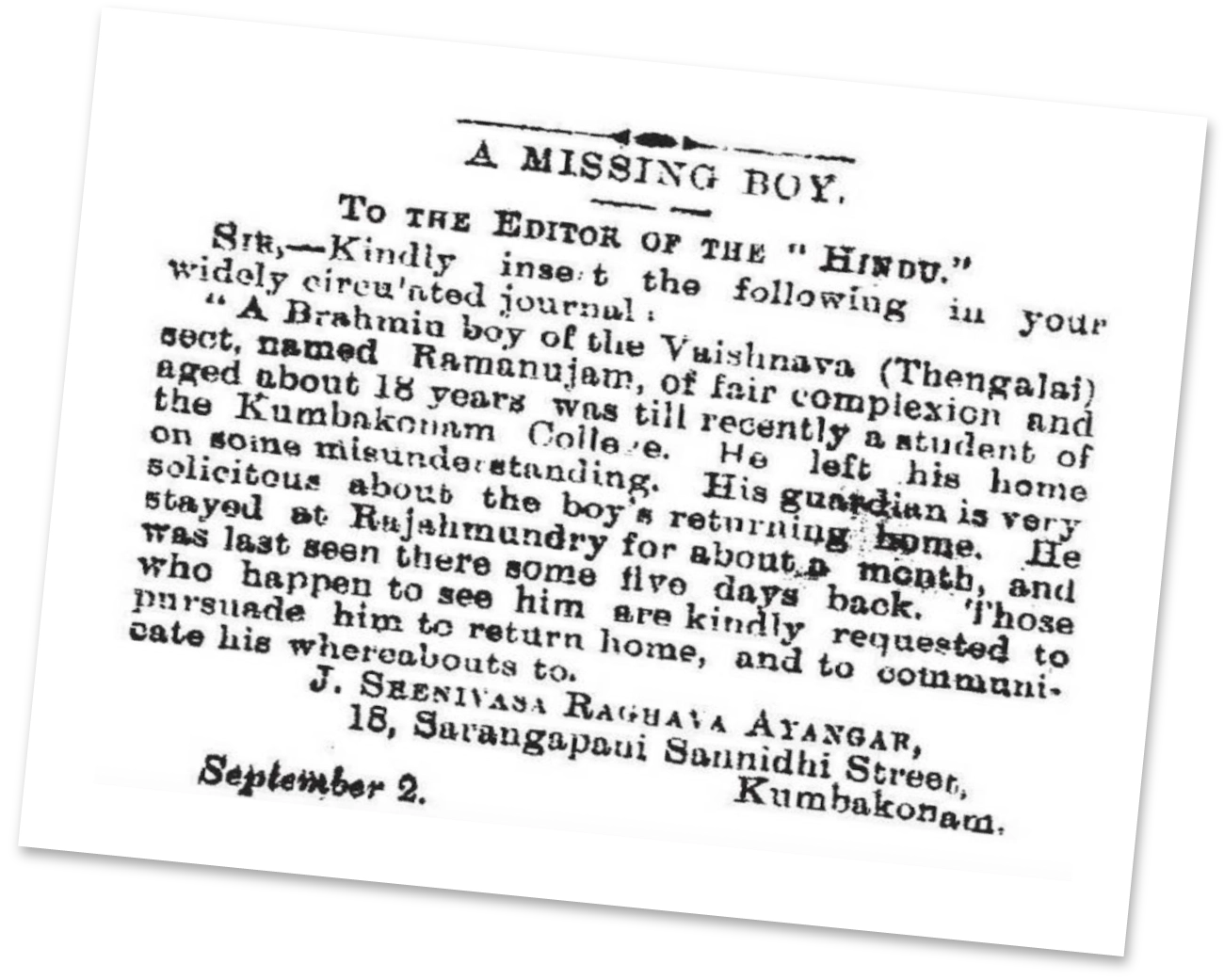
After failing out of college, Ramanujan ran away from home, prompting his mother to post a missing-person notice in The Hindu.
The Hindu
He continued his research on his own for years, often while in poor health. During that time, he tutored students in math to support himself. Eventually he secured a job as a clerk at the Madras Port Trust in 1912. He pursued mathematics on the side and published some of his results in Indian journals.
Hoping to get some of his work into more prestigious and widely read publications, Ramanujan wrote letters to several British mathematicians, enclosing pages of findings for their review. “I have not trodden through the conventional regular course which is followed in a university course,” he wrote, “but I am striking out a new path for myself.” Among the recipients was Hardy, an expert in number theory and analysis at the University of Cambridge.
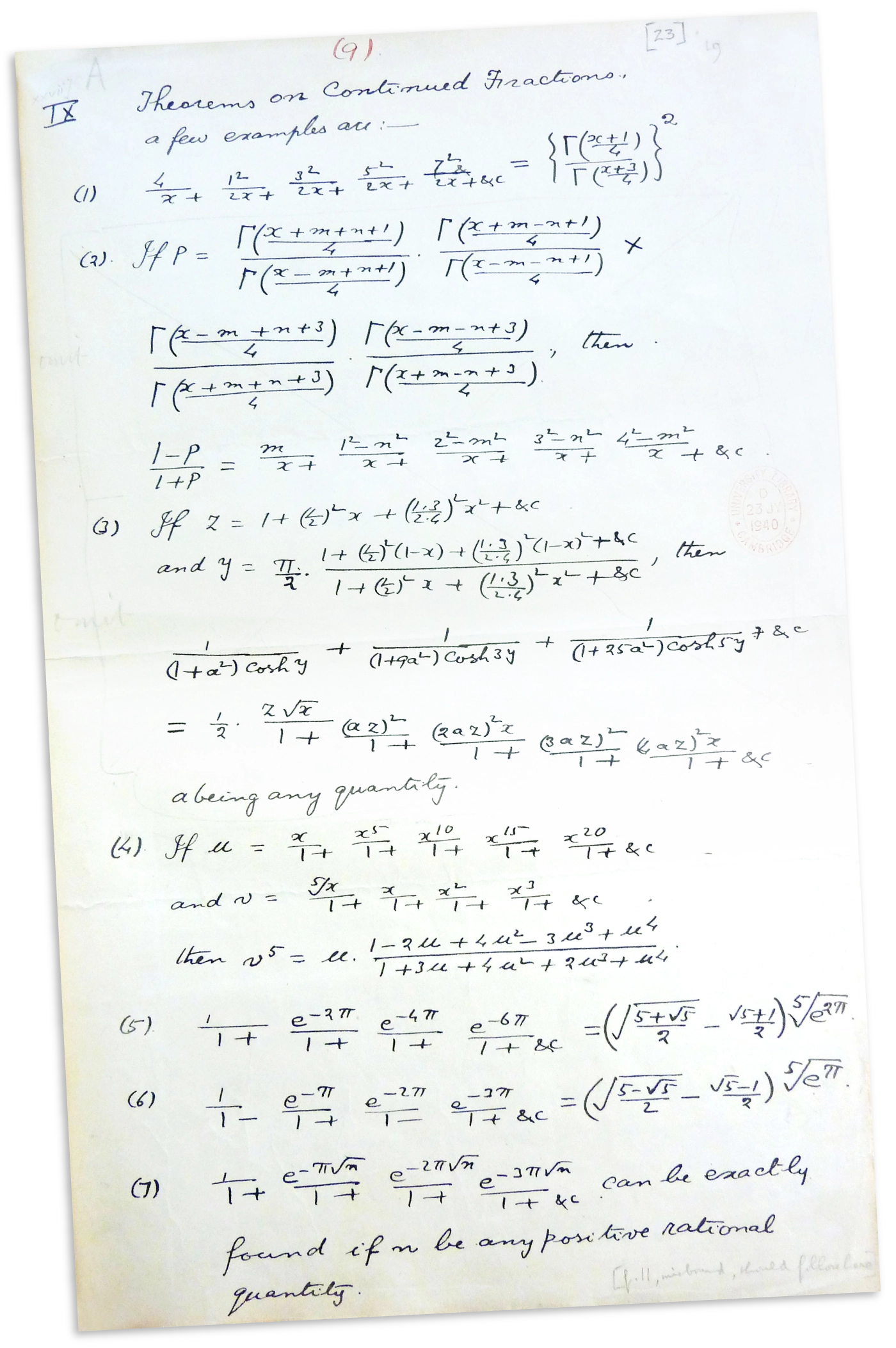
Ramanujan’s first letter to G.H. Hardy included formulas (5), (6) and (7), strange nested fractions that Hardy said “defeated me completely; I had never seen anything in the least like them before.”
Courtesy of Ken Ono
Hardy was shocked at what he saw. Ramanujan had identified and then solved a number of continued fractions — expressions that can be written as infinite nests of fractions within fractions, such as:
They “defeated me completely; I had never seen anything in the least like them before,” Hardy later wrote. “They must be true because, if they were not true, no one would have had the imagination to invent them.” The formulas, unproved, were so striking that they inspired Hardy to offer Ramanujan a fellowship at Cambridge. In 1914, Ramanujan arrived in England, and for the next five years he studied and collaborated with Hardy.
One of Ramanujan’s first tasks was to prove a general statement about his continued fractions. To do so, he needed to prove two other statements. But he couldn’t. Neither could Hardy, nor could any of the colleagues he reached out to.
It turned out that they didn’t need to. The statements had been proved 20 years earlier by a little-known English mathematician named L.J. Rogers. Rogers wrote poorly, and at the time the proofs were published no one paid any attention. (Rogers was content to do his research in relative obscurity, play piano, garden and apply his spare time to a variety of other pursuits.) Ramanujan uncovered this work in 1917, and the pair of statements later became known as the Rogers-Ramanujan identities.
Amid Ramanujan’s prodigious output, these statements stand out. They have carried through the decades and across nearly all of mathematics. They are the seeds that mathematicians continue to sow, growing brilliant new gardens seemingly wherever they fall.
Ramanujan fell ill and returned to India in 1919, where he died the next year. It would fall to others to explore the world his identities had revealed.
The Music of the Game
Hussein Mourtada grew up in the 1980s in Lebanon, in a small city called Baalbek. As a teenager, he didn’t like studying and preferred to play: soccer, billiards, basketball. Math, too. “It looked like a game,” he said. “And I liked playing.”
As an undergraduate at the Lebanese University in Beirut, he studied both law and mathematics, with an eye to a legal career. But he soon found that while he enjoyed the philosophical aspects of law, he did not enjoy it in practice. He turned his attention to math, where he was particularly drawn to the community. As a child, his teachers and classmates were what excited him about going to school, even though he often fell asleep during class. As a budding mathematician, “I had the impression that these are beautiful people,” he said. “They are honest. You need to be honest with yourself to be a mathematician. Otherwise, it doesn’t work.”
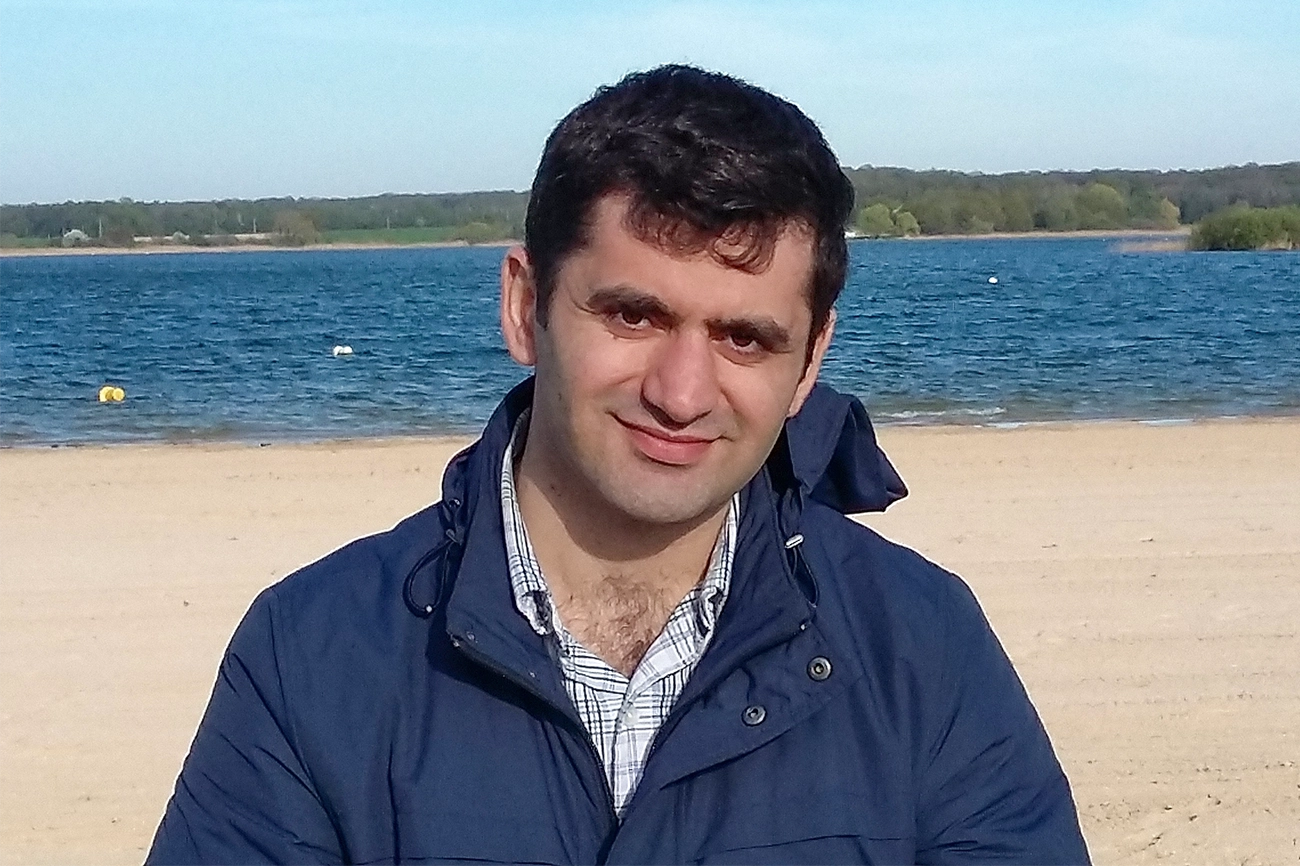
Hussein Mourtada has been bringing Ramanujan’s work into the 21st century.
Basma Jaffal
He moved to France for his doctorate and started to focus on algebraic geometry — the study of algebraic varieties, or shapes cut out by polynomial equations. These are equations that can be written as sums of variables raised to whole-number powers. A line, for instance, is cut out by the equation x + y = 0, a circle by x2 + y2 = 1, a figure eight by x4 = x2 − y2. While the line and circle are completely smooth, the figure eight has a point where it intersects itself — a singularity.
It’s easy to spot singularities when you’re dealing with shapes that you can draw on a sheet of paper. But higher-dimensional algebraic varieties are far more complicated and impossible to visualize. Algebraic geometers are in the business of understanding their singularities, too.
They’ve developed all sorts of tools to do this. One dates back to the mathematician John Nash, who in the 1960s started studying related objects called arc spaces. Nash would take a point, or singularity, and define infinitely many short trajectories — little arcs — that passed through it. By looking at all these short trajectories together, he could test how smooth his variety was at that point. “If you want to see if it’s smooth, you want to pet it,” said Gleb Pogudin of the École Polytechnique in France.
In practical terms, an arc space provides an infinite collection of polynomial equations. “This is really the thing that Mourtada is expert in: understanding the meaning of those equations,” said Bernard Teissier, a colleague of Mourtada’s at the Institute of Mathematics of Jussieu in Paris. “Because these equations can be very complicated. But they have a certain music to them. There is a lot of structure which governs the nature of these equations, and he’s just the person, I think, who best listens to this music and understands what it means.”
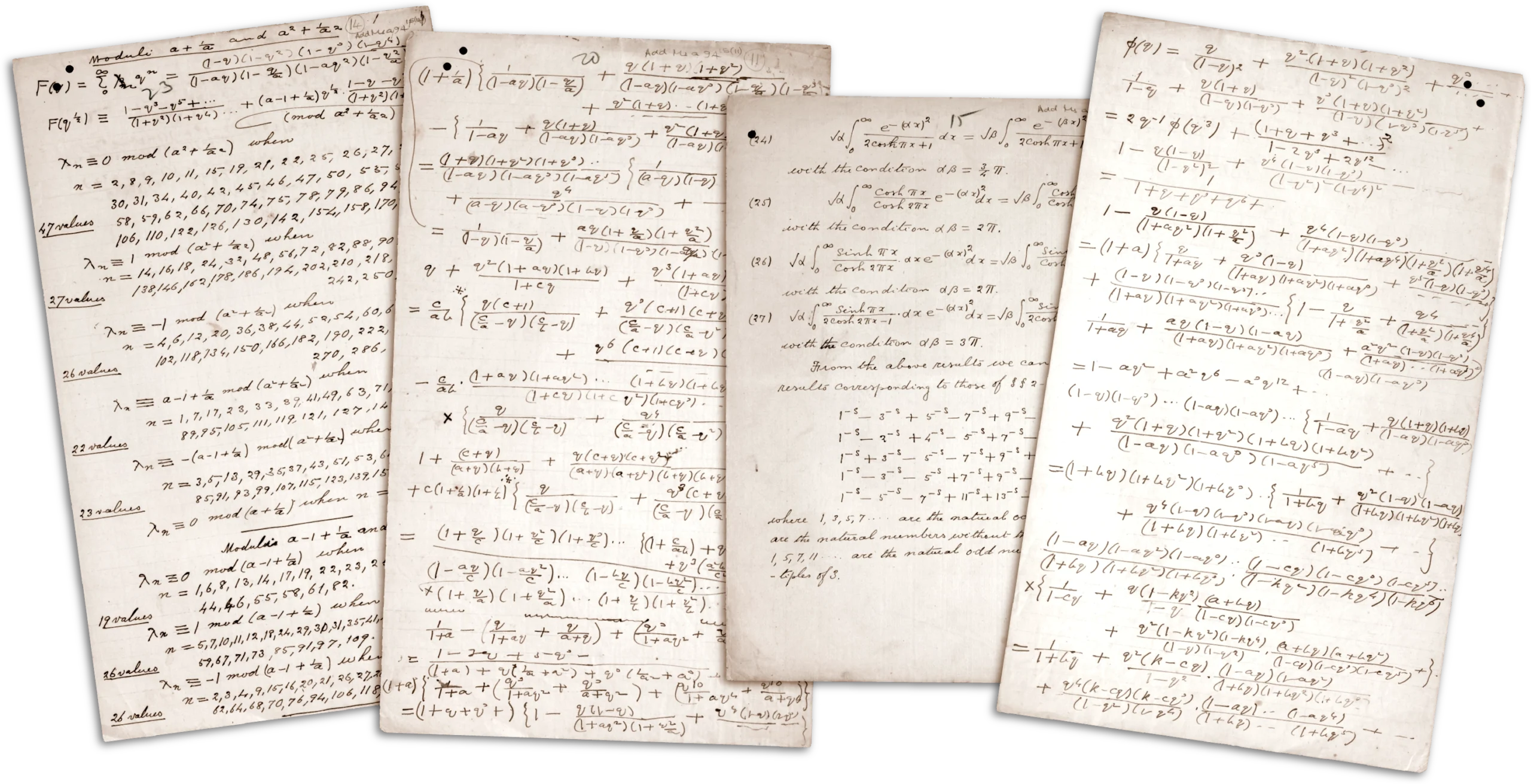
Pages from Ramanujan’s lost notebook.
Trinity College, Cambridge
Shortly after graduate school, Mourtada and two other young mathematicians, Jan Schepers and Clemens Bruschek, were studying the arc space associated with a very simple kind of singularity. They broke up the space to better understand it, just as an archaeologist separately examines the layers of an ancient site.
Eventually they got stuck, but something kept nagging at Mourtada. He and his colleagues had computed a series of numbers. These numbers corresponded to how many polynomials there were in each of the first few pieces of the arc space. They somehow looked familiar. “I kept on repeating them like a child,” he said. “And then suddenly I remembered.”
Hidden Patterns Everywhere
The Rogers-Ramanujan identities are like an enormous cut emerald: immensely complex and beautiful, and appearing utterly different depending on your perspective.
Each identity sets a complicated infinite sum equal to a complicated infinite product. As such, the statements reveal a strange link between two mathematical functions (addition and multiplication) that shouldn’t, in this context, have much to do with each other.
Other researchers quickly came to see unexpected mathematical wonders in them. The English mathematician Percy MacMahon started his career in the late 19th century as a soldier, only for illness to steer him away from the military and into math. In 1915, he was writing the first comprehensive textbook on combinatorics, a subject that deals with counting methods. He read about the equations that would later be dubbed the Rogers-Ramanujan identities and realized that just below the surface, the functions on either side of the equal sign were also about counting.
Consider an integer such as the number 4. It can be broken up into parts in a finite number of ways: You can write it as 4, as 3 + 1, as 2 + 2, as 2 + 1 + 1 or as 1 + 1 + 1 + 1. Mathematicians say that the number 4 has five “partitions.” Bigger numbers have far more partitions: The number 200, for instance, has nearly 4 trillion. Partitions are so basic that “people have thought about them as long as people have thought about mathematics,” said Andrew Sills of Georgia Southern University.
The first mathematician to study partitions systematically was Leonhard Euler in the 18th century. He proved the very first partition identity: that for any integer (say, 4), the number of partitions whose parts are all odd (two partitions in this case: 3 + 1 and 1 + 1 + 1 + 1) is equal to the number of partitions whose parts are all distinct, meaning there are no repetitions among them (4 and 3 + 1).
MacMahon saw that the two Rogers-Ramanujan identities could be interpreted in a similar way. (The German mathematician Issai Schur, isolated due to World War I, independently discovered the identities and came to the same conclusion.) The sum side of the first Rogers-Ramanujan identity counts the number of partitions of a given integer that don’t have any duplicated or consecutive parts. (For the number 4, there are two: 4 and 3 + 1.) The product side counts the number of partitions whose parts all leave a remainder of 1 or 4 when divided by 5 (4 and 1 + 1 + 1 + 1). For any integer, the number of partitions satisfying each condition will always be equal.
Mark Belan/Quanta Magazine
“This is a very weird fact. It’s mysterious,” said Shashank Kanade of the University of Denver. “I mean, where did the 5 come from?”
For much of the 20th century, mathematicians would delight in thinking about the strange hidden phenomena that Ramanujan had unearthed. During World War II, for instance, the physicist Freeman Dyson wrote that he “kept sane by wandering in Ramanujan’s garden.”
But it wasn’t until the late 1970s that they uncovered additional facets of the Rogers-Ramanujan identities. It started when an Australian physicist named Rodney Baxter created a simplified model of a gas in order to understand phase transitions, the points at which a system’s behavior suddenly changes (like when liquid water turns to ice). While computing certain key numbers in his model, he rediscovered the Rogers-Ramanujan identities through the lens of statistical mechanics.
Around the same time, the Rutgers mathematicians James Lepowsky and Robert Wilson proved that the Rogers-Ramanujan identities also arise in representation theory, the mathematical study of special symmetries. Their result opened a whole new field — the theory of so-called vertex operator algebras, which are used today in string theory, and which played a key role in one of the biggest recent results in group theory: the proof of the “monstrous moonshine” conjectures.
“You begin to see that these identities are natural. They are part of a general frame of things, which is much, much more general than just the partition identities,” Teissier said.
This trend of the Rogers-Ramanujan identities surfacing in various fields of mathematics continued into the 1990s and 2000s. They appeared in number theory, in the study of central functions called modular forms; in probability theory, in work on Markov chains; and in topology, in polynomials used to distinguish and classify knots. Each time, the identities could be re-proved using techniques from those fields — and each time, mathematicians could exploit those connections to produce new identities, planting more and more seeds in Ramanujan’s garden.
Magic Numbers
In 2010, as Mourtada was pondering the arc space of a simple singularity called a fat point, he had something of a revelation. To understand the singularity’s deeper structure, he had divided the corresponding arc space — essentially a complicated system of infinitely many polynomial equations — into layers, and had started to count the number of polynomials in each one.
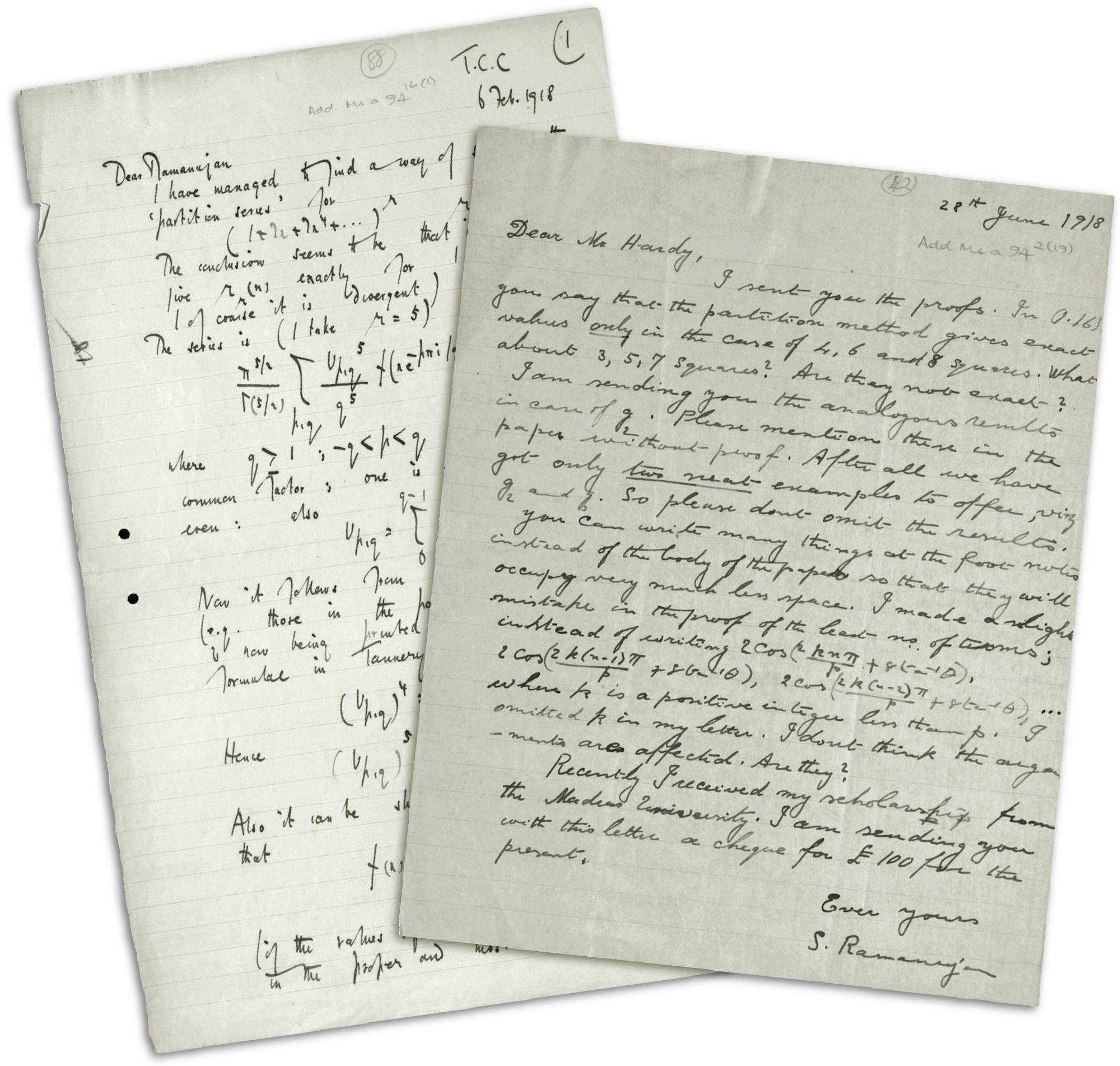
Hardy and Ramanujan collaborated closely for years. They exchanged letters about mathematics until Ramanujan’s death.
Trinity College, Cambridge
The numbers he ended up with, he noticed, weren’t random. The sum side of the Rogers-Ramanujan identity — the number of partitions with no equal or consecutive parts — “suddenly came to my mind,” he said. “I figured out that even if I was counting something which is different from partitions, this was actually exactly what I was counting.”
It made sense, he realized. It’s long been known that you can associate a polynomial equation to any partition. But each piece of Mourtada’s arc space included only a specific subset of polynomials, and therefore only a specific subset of partitions. And Mourtada wanted to count them — precisely the purview of partition identities such as those of Rogers and Ramanujan.
He, Bruschek and Schepers proved that the structure of their arc space could be described by this identity. “It’s very surprising that such a simple singularity could have such a deep underlying structure,” Schepers said. “We were very excited.” Excited enough for Mourtada to jump on his desk.
Bruschek and Schepers left mathematics soon afterward. But Mourtada continued to build on their work. “You could say this was the baby case,” Teissier said. Over the next decade, “he made the whole thing much more conceptual … a completely general type of business.”
In 2015, a young Iranian mathematician named Pooneh Afsharijoo arrived in France to begin her graduate studies with Mourtada. Since then, the two have been working together to understand many other (and much more complicated) singularities and their arc spaces. That’s led them to find a wealth of new identities — and an extension of the oldest one. The Rogers-Ramanujan identity says that the same number of partitions always satisfies two very different conditions. Afsharijoo, now a postdoctoral researcher at the Complutense University of Madrid, discovered a third condition, expanding the scope of the original identity that Ramanujan had written down over 100 years earlier.
Now, Mourtada and Afsharijoo are also using networks of points and edges called graphs to represent information about their arc spaces, allowing them to apply tools from graph theory to uncover additional novel partition identities. This new connection adds even more evidence to “the magic which is inside the integers,” Afsharijoo said.
Partitions and the Primes
Every time the Rogers-Ramanujan identities pop up somewhere new, mathematicians are both surprised and unsurprised. The unexpected appearance of the identities offers a fresh connection to explore, further evidence of the mysterious unity between the many different fields of math. “The surprise of it has not worn off. It still seems unreasonable that all these things are true,” said George Andrews of Pennsylvania State University.
But when it comes to these identities, everyone also expects the unexpected. “That’s kind of the trademark of Ramanujan’s kind of mathematics,” said Ken Ono of the University of Virginia.
In September, Ono and two collaborators — William Craig and Jan-Willem van Ittersum — published yet another application for partition identities. Rather than looking for a new source from which these identities would spring, they were able to use them for an entirely different purpose: to detect prime numbers.
They took functions that counted partitions and used them to build a special formula. When you plug any prime number into this equation, it spits out zero. When you plug in any other number, it instead spits out a positive number. In this way, the partition identities can give you a way to pick out the entire set of primes from the integers, Ono said. “Isn’t that crazy?”
“Partitions are about adding and counting,” he said. “Why would they be able to detect which numbers are prime or not, on the nose, which is a multiplication thing?”
By tapping into the rich mathematical theory of modular forms, he and his colleagues found that this formula was just a glimpse of a much larger class of prime-detecting functions — infinitely many, in fact. “That’s mind-blowing to me,” Ono said. “I hope people find it beautiful.” It indicates a deeper relation between the partitions and multiplicative number theory that mathematicians are now hoping to explore.
In some ways, it makes sense that partitions keep infiltrating every corner of mathematics. “The theory of partitions is so basic,” Andrews said. “Counting stuff and adding stuff up happens in almost every branch of mathematics.”
Still, the precise nature of those connections is hard to work out. “It’s really about getting the perspective right,” Ono said.
“This is the great thing about Ramanujan’s work,” Kanade said. “It’s not just one identity he discovered, and a dead end. It’s always the tip of an iceberg. You just have to follow it through.”
“Ramanujan is someone who can imagine things that someone like me cannot,” Mourtada said. But the development of new fields of mathematics has “given us the possibility to find new partition identities that Ramanujan could probably have found just by imagination.”
“That’s why mathematics is so important,” he added. “It allows ordinary people like me to find these miracles, too.”
